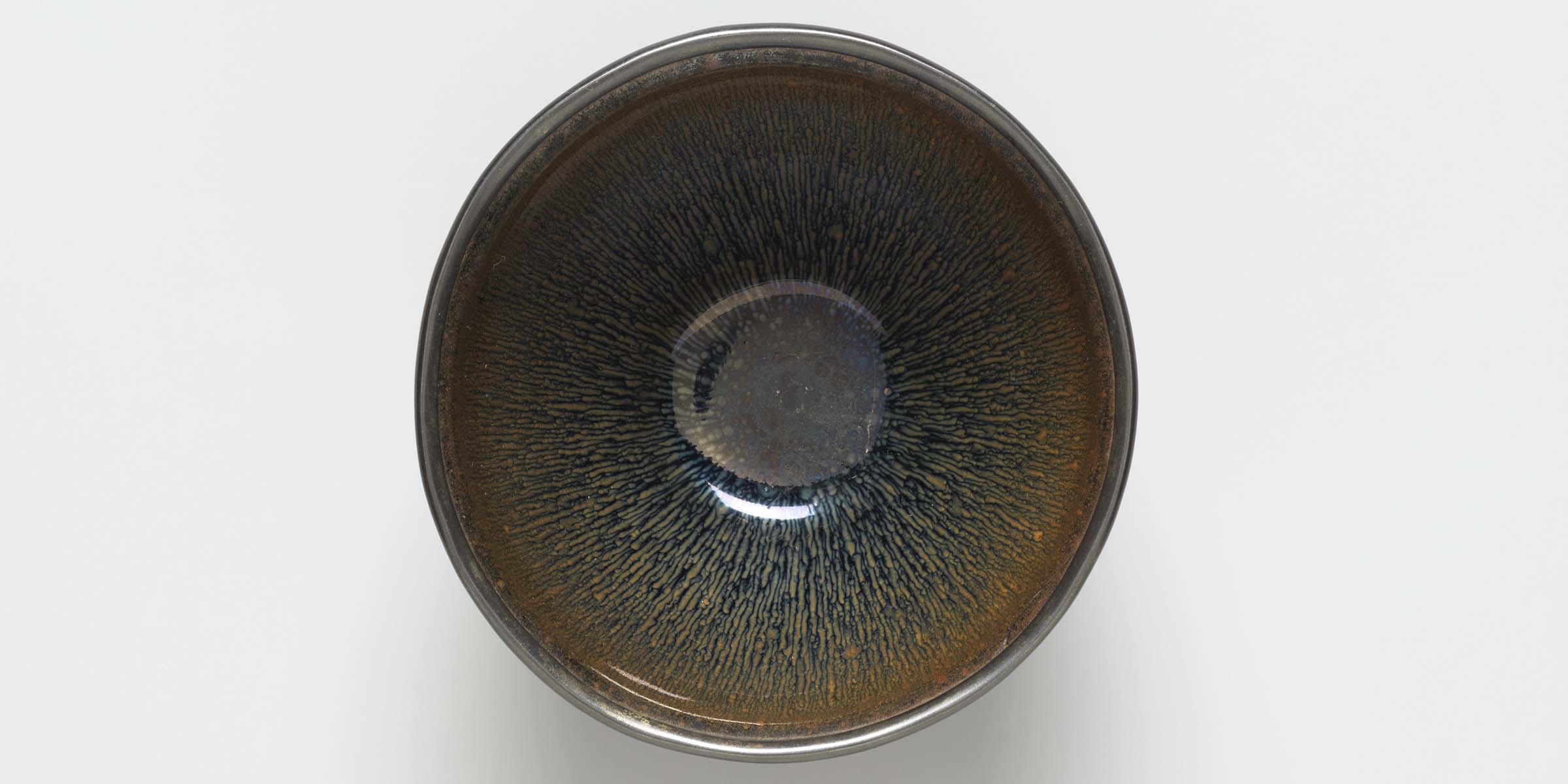The ceramic kiln is like a black box: pots are fired at temperatures upwards of 2,000 degrees Fahrenheit, and while the flames are being stoked within, there is no way of knowing exactly what will happen. Accidents inevitably occur—a bit of ash falls on the exterior of a pot, or the silica in a glaze crystallizes more than expected. Such serendipity created the yuteki tenmoku chawan, a tea bowl characterized by its speckled blue-black glaze. The name refers to the silver spots splattered on the surface of the vessel; these emerge as part of a chemical reaction set off by a high-temperature kiln firing. Shimmering like coins against a dark backdrop, the iridescent specks are said to take on the appearance of yuteki, or oil droplets.
The Kyushu National Museum houses an exemplary yuteki tenmoku chawan, with a sumptuous, glossy finish and gold-rimmed lip. In recognition of the bowl’s singular beauty, Japan’s Agency for Cultural Affairs has marked it as “Important Cultural Property,” a designation afforded only to objects and structures of utmost importance to Japanese culture and history. To aid in the preservation of “Tangible Cultural Properties,” the government regulates alterations to the object’s current state and places restrictions on its export. Yet this yuteki tenmoku chawan is not, strictly speaking, Japanese—the bowl was produced in a kiln in China and imported into Japan to be used for matcha, a powdered form of the tea leaf camellia sinensis that is whisked into a milky froth.
Japan’s claim to cultural ownership over this Chinese tea bowl illuminates the delicate tension between appreciation and appropriation. Though the bowl’s provenance is not Japanese, it symbolizes an innovative cultural practice paramount to understanding Japanese history, one that fused art and politics with the rituals of tea. This practice, known as chanoyu—literally “hot water for tea,” but often translated as “the Japanese tea ceremony”—was largely a conduit for the appreciation of objects employed or displayed during the gathering. Tea utensils were so prized by chanoyu practitioners—many of whom were daimyo, or warrior lords—that they functioned as reconciliation prizes, gifts of surrender, and even reasons to begin wars. The special designation given to the yuteki tenmoku chawan on display at the Kyushu National Museum is, to a degree, a continuation of this culture of art appreciation.
Yet this title also reflects the mythic valorization of chanoyu today, a process that began in the twentieth century in the service of Japanese nationalism. Backed by political and commercial interests, contemporary accounts of the history of tea in Japan have been recast as myths, ignoring chanoyu’s complex origins to promote Japanese culture abroad. These resulting narratives often gloss over commercial and geopolitical relations between Japan and other Asian countries that facilitated the development of chanoyu, obscuring a tricky history of how mercantile interests catalyzed a revolution in aesthetic taste.
In sixteenth-century Japan, tea practitioners regularly brought home objects from other parts of Asia, particularly China and Korea, for use in tea. While most of these objects, especially those from China, were already used in existing tea traditions, some were wares of daily life that were repurposed by Japanese tea devotees. Removed from their original contexts, foreign goods were revered as art objects. Such acts of appropriation were not performed out of disregard for other cultures. Instead they celebrated the particular beauty embodied by objects from outside of Japan and often drove innovation within Japanese tea culture.
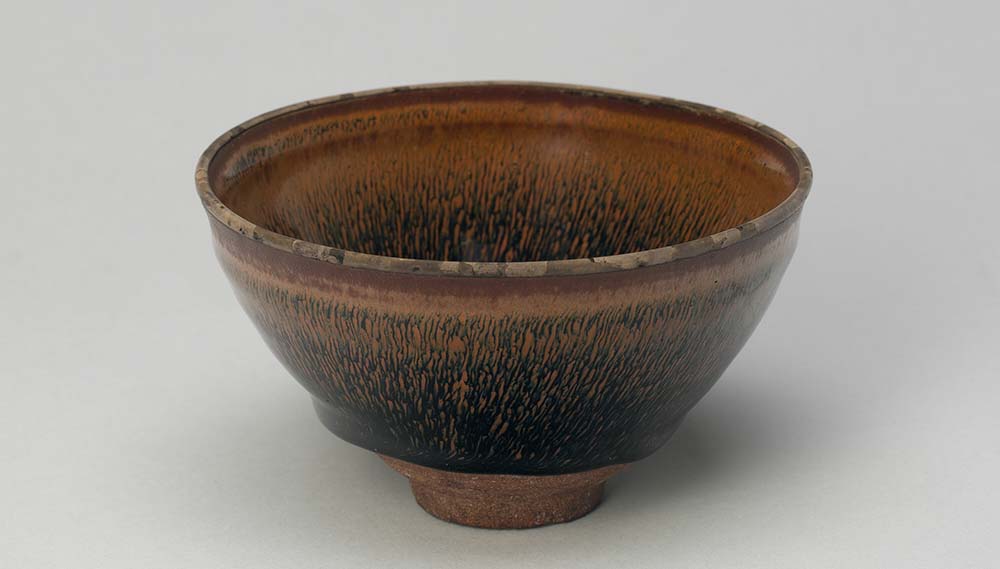
In the 1996 catalogue Hare’s Fur, Tortoiseshell, and Partridge Feathers: Chinese Brown and Black Glazed Ceramics, 400–1400, the scholar Nicole Coolidge Rousmaniere observes that matcha was introduced to Japan from China during the Kamakura period (1185–1333). Though tea-drinking had been practiced in Japan from as early as the Nara period (710–784), whisked tea was a new commodity, linked to the importation of a new ceramic form known as the tenmoku tea bowl, or Jian ware. The term chanoyu would not appear in historical documents until the Muromachi period (1336–1573), when the warrior elite began hosting decadent gatherings in banquet-style structures called kaisho, often situated in the garden of a residence. These gatherings were replete with food, drink, and entertainment and provided a means for the elite to flaunt their largely Chinese art collections. At the time the dominant aesthetic in tea was karamono-suki, “a love for Chinese things,” sustaining a much longer history of appreciation for Chinese painting and poetry. With whisked tea elegantly capping off a raucous evening, kaisho banquets paved the way for chanoyu’s refinement later in the sixteenth century.
By the late fourteenth and early fifteenth centuries, as scholar Dale Slusser discusses in a 2007 essay, shops specializing in Chinese tea utensils became popular in Kyoto, then the capital of Japan. Over time, purveyors of imported utensils accumulated enough wealth to become collectors, too. But rather than reproducing the kaisho manner of entertainment established by military leaders, elite merchants created a new practice known as the sōan, or grass hut, style of tea. Formed in opposition to the lavish kaisho feasts, sōan tea gatherings took place in new architectural structures, unadorned and of humble construction, yet still extravagant in their calculated simplicity. The average sōan tearoom fit just four-and-a-half tatami mats, and the smallest recorded structure included only two mats—one for the guest and one for the host.
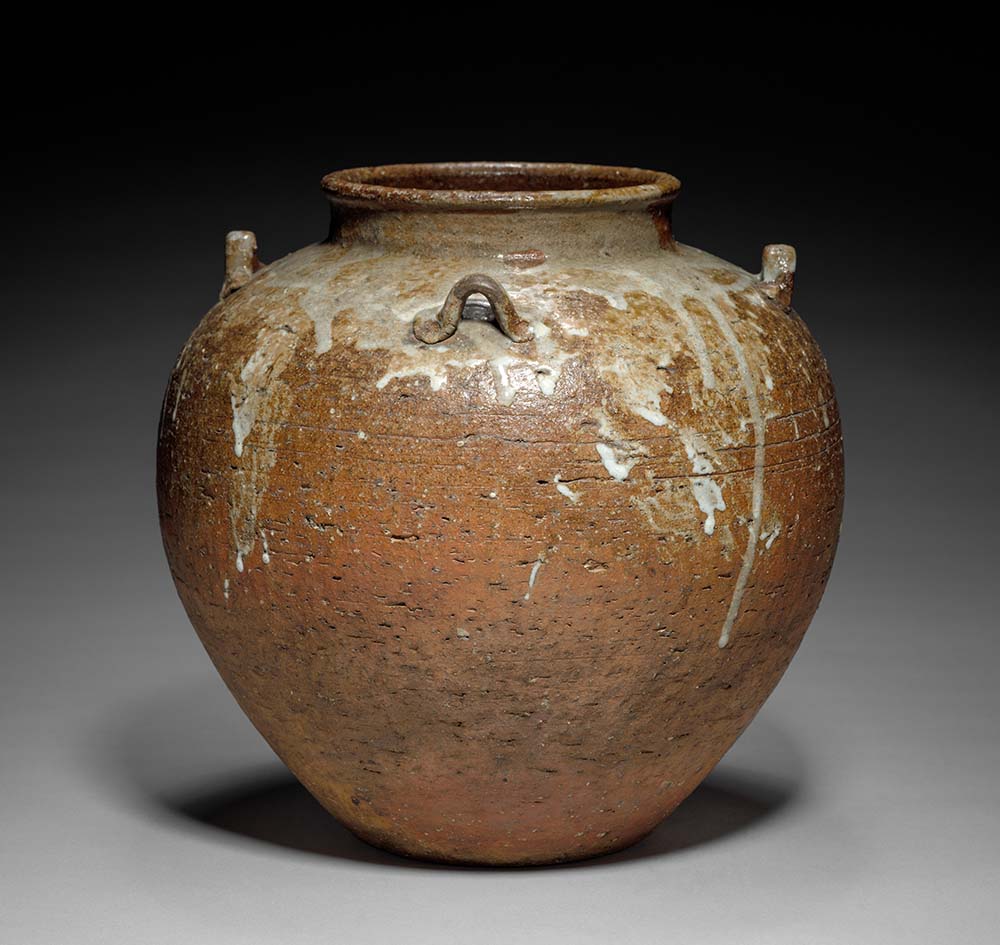
The cultivation of this new aesthetic in tea—known as wabi (詫び), meaning “forlorn” or “pitiful” and referring to the beauty in imperfection and austerity—emerged in part from the importation of utilitarian objects from China, Korea, and South Asia for use in chanoyu. One such object was a large jar from mid-thirteenth or fourteenth-century China, mass-manufactured to ensure durability in storage and transport rather than for display. Although historians are uncertain as to whether the jar was initially imported as a shipping container for another commercial item or as a standalone product, Japanese tea devotees reused it to store tea leaves. With prolonged use, the jar accrued the signatures of its owners—many of whom were famous connoisseurs—and slowly gained renown within the tea community. Tea practitioners dressed this particular jar in brocaded silk and called it “Chigusa,” meaning “thousand grasses” or “myriad things”—a phrase borrowed from Japanese poetry, signaling a high degree of respect and admiration. Much like other meibutsu, or “named things”—objects elevated from the everyday and bestowed with special titles—Chigusa was subject to careful, meditative examination during tea gatherings. Despite its crude craftsmanship, particularly compared to celadon or the famed blue-and-white porcelain of China, tea lovers in Japan revered the ceramic vessel, finding beauty in the flaws that pockmarked its body. The adaptation of utilitarian wares such as Chigusa for use in tea revived objects by granting them an esteemed position in chanoyu, giving new life to commodities that may have otherwise been discarded.
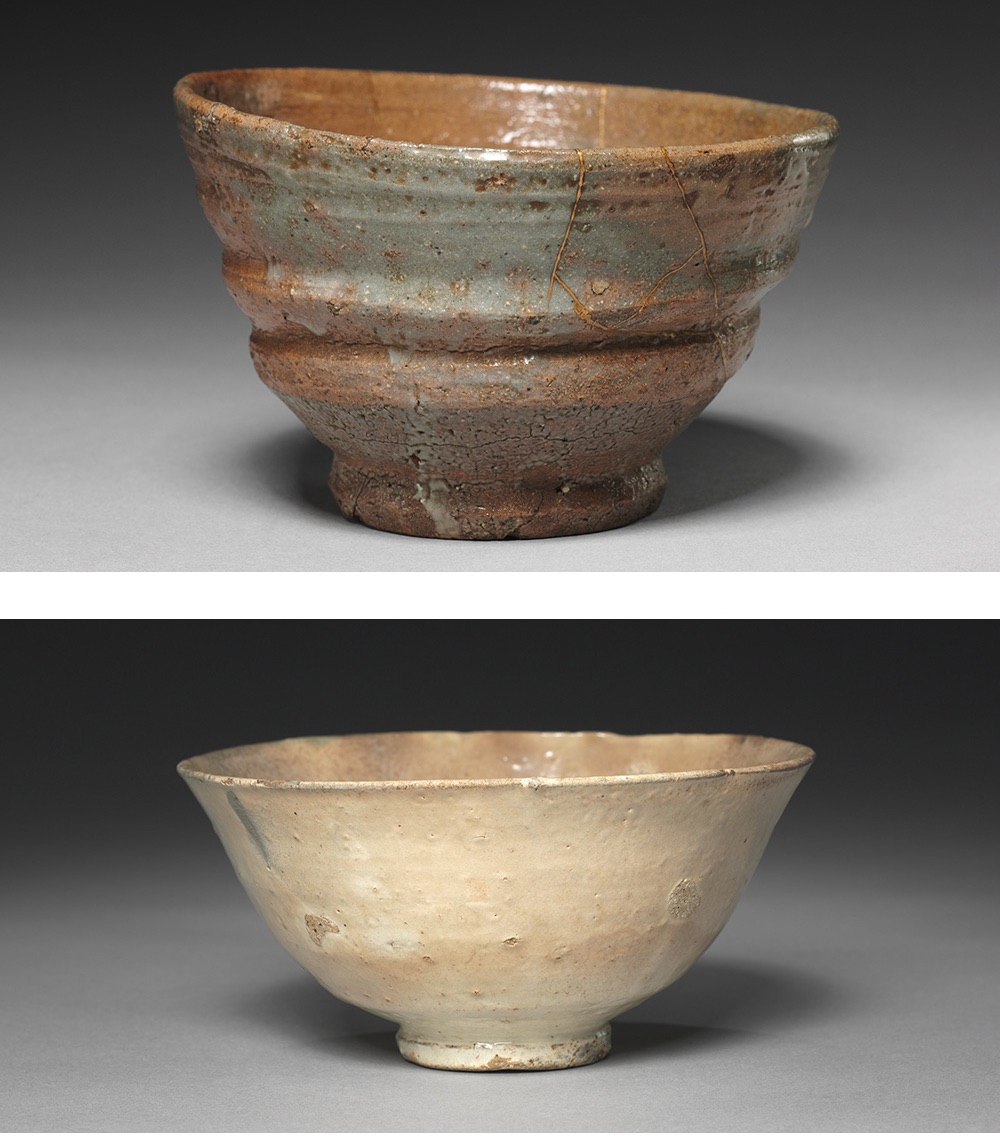
Ceramics from Joseon-era Korea, known as kōrai mono (Korean objects), were also popular among this new generation of tea masters, and integral to the cultivation of wabi-cha. The kōrai chawan (Korean tea bowls) used by Japanese tea practitioners were not considered high-quality ceramics in Korea, according to historian Nam-lin Hur. Cheaply produced, these simple bowls were intended for everyday use by the masses. Yet Hur suggests that kōrai chawan were integral to an aesthetic shift in tea away from karamono-suki. Katade tea bowls (堅手茶碗, “strong hand” tea bowl) from the early Joseon dynasty, made from porcelain and quick to develop stains, were valued by Japanese tea masters, who found beauty in the traces of use. Following the Imjin War (1592–1598), in which Toyotomi Hideyoshi unsuccessfully invaded Korea twice, Korean ceramicists introduced new ceramic techniques to Japan, such as the Motoyashiki multi-chambered climbing kiln, which increased the production volume of local wares. Hideyoshi, like other warrior elites, had been an avid champion of chanoyu. Many kiln sites in Japan, such as Karatsu—now famous for a style of ceramics called Mishima—were established by Korean potters captured by Hideyoshi’s army and brought over to Japan during the war. The white, slip-inlaid designs seen on Mishima Karatsu ware made in Japan had been introduced to the country’s collectors as imported Buncheong kōrai chawan. The exoticization of Korean bowls, transformed from domestic goods into the exemplar of an aesthetic ideal, allowed for the emergence of this new style of tea, wabi-cha, propagated by the merchant class.
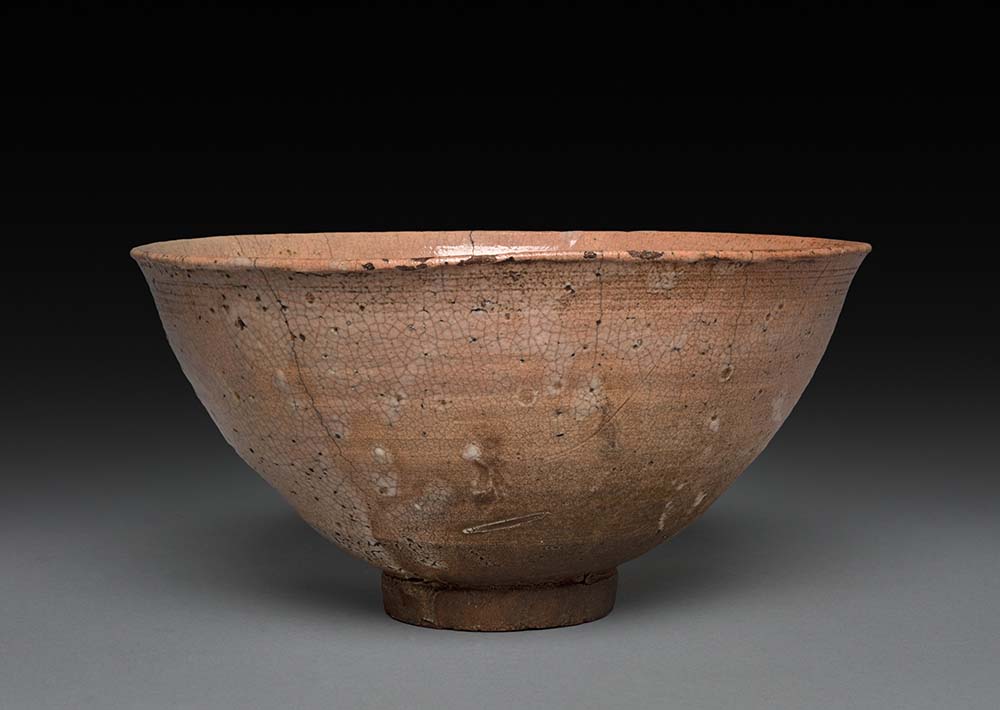
Hur notes that Sen no Rikyū, the sixteenth-century tea merchant most often credited with refining the wabi style of tea, eventually adopted Korean tea bowls and utensils. Although Rikyū initially practiced chanoyu by combining Chinese and Japanese objects, Hur argues that he ultimately discovered wabi in kōrai mono, which “had a warmth unknown to the works of China and a delicacy of texture and craftsmanship not found in Japan.” Much like the humble Chigusa, the hasty, imperfect construction of Korean tea bowls exemplified wabi’s aesthetic ideals, while simultaneously offering an untapped market of tea utensils for merchants like Rikyū to exploit.
Although tea would remain integral to both business and statecraft throughout the Edo period (1603–1867)—a time of relative peace and artistic flourishing, during which Japan kept itself closed off from the Western world—the Meiji Restoration, beginning in 1868, initiated a major cultural reformation in Japan. Traditional practices like chanoyu were outlawed, and Japan rapidly industrialized, participating in global trade and gaining access to modern technologies. As ideals of Western modernism gained influence and Japan sought to prove itself as a global power, purveyors of Japanese culture began to panic—and grow nostalgic. Romanticized narratives about the culture of “old Japan,” often catering to Western audiences, proliferated. Many of these stories involved chanoyu.
In a 1906 volume titled The Book of Tea, Japanese art curator Okakura Kakuzō presents a secular religion of aestheticism oriented around the tradition of tea in Japan that he terms “Teaism,” a portmanteau of “tea” and “Taoism.” Seamlessly melding the language of spiritual salvation with the aesthetic sublime, Okakura claims that this “Philosophy of Tea is not mere aestheticism” but the guiding principle of the Japanese national spirit. That is, through the cultivation of aesthetic taste in chanoyu, Okakura suggests that one may come to know what it means to be Japanese.
Originally written in English for an American audience, Okakura’s book carries a tinge of bitterness as it implores readers to revere, rather than belittle, the great nation of Japan. Although slim, The Book of Tea is as enterprising as it is ambitious, first guiding readers through the history of tea in East Asia before describing each element of Japanese tea practice (including architecture, art display, flower arrangement, history). In this way, Okakura seeks to offer an alternative aesthetic paradigm to Western tastes, with Japan at its center.
The Book of Tea sought to challenge Western preconceptions about Japanese culture. Okakura’s methods of achieving that end, however, involved a process of self-Orientalization, reducing cultural traditions to Orientalist stereotypes. The text is riddled with koan-like proverbs that infuse aesthetic philosophy and historical exposition with a messianic fervor. “Those who cannot feel the littleness of great things in themselves are apt to overlook the greatness of little things in others,” Okakura wrote, imploring his readers to search for a new creative sensibility, one different from what they already know, in something as simple as a cup of tea.
A protégé of the American Orientalist Ernest Fenollosa, a curator at the Museum of Fine Arts in Boston, Okakura was a savvy internationalist. His expatriation to America in 1906 and his motivations for writing The Book of Tea had been driven, in part, by the repressive policies of the Meiji government. Okakura was also a staunch nationalist, one who feared that the Meiji Restoration’s modernization program endangered Japanese traditions. In his 1993 journal article “The Zen of Japanese Nationalism,” UC Berkeley professor Robert Sharf identified The Book of Tea as part of an emerging literature called nihonjinron. Such works idealized the Japanese character, mirroring the country’s escalating militarization. The Book of Tea was published the year after Japan’s victory in the Russo-Japanese War and a few years before the country’s 1910 annexation of Korea. Okakura’s English books did not gain much traction in Japan before his death in 1913. But by the 1930s, militant nationalists in Japan embraced Okakura’s work for their own agendas.
In reaching for the traditional arts of Japan, cultural pundits such as Okakura sought to carve out a distinct national identity that could compete with Western constructs of uniqueness and individual genius. An undercurrent of alarm delicately traces Okakura’s language: “Some of my compatriots have adopted too much of your customs and too much of your etiquette, in the delusion that the acquisition of stiff collars and tall silk hats comprised the attainment of your civilization,” he writes in The Book of Tea. Later works, such as In Praise of Shadows, written by the novelist Tanizaki Jun’ichirō and published in 1933, echo Okakura’s anxiety, similarly conflating aestheticism with nationalism. Drawing upon references to architecture, lacquerware, and Nōh theater, Tanizaki mourns the loss of Japan’s cultural identity, suggesting that the traditional arts of Japan are best viewed in the darkness of shadow, rather than the bright whitewashed walls of Western modernity. While Okakura wrote The Book of Tea in a place of cultural exile, Tanizaki was already an esteemed author in Japan by the time he published In Praise of Shadows. Written for a subsidiary of the newspaper AsahiShimbun, his sixteen-part essay appeared at a moment when the country had rebounded from the cultural suppression of the Meiji Restoration.
The Book of Tea introduced audiences outside of Japan to a mythos in which the appreciation of tea and its accompanying objects symbolized the nation’s spirit. Through the circulation of this myth throughout the twentieth century, commercial entities promoted Japanese commodities abroad. Visitors to the Japanese Pavilion of the 1939 New York World’s Fair encountered an array of pamphlets and presentations that introduced Japanese culture and promoted “exotic” commodities such as tea. By then Japan had firmly established itself as a modern world power with an imperial empire spanning much of Asia. Its participation in the fair signaled the nation’s might as a global superpower—none of Japan’s colonies had a seat in the fair’s Hall of Nations—and distracted Americans from the aggression of the ongoing Sino-Japanese war. One pamphlet suggests that tea is the perfect “translation of Japanese character,” echoing the nostalgic and nationalistic tone of The Book of Tea. It describes “CHA-NO-YU” as “a development from ancient days,” in which guests “kneel on mats, dignified, placid, as becomes those who silently commune on the high destiny of man in the universe,” and consume matcha, deemed the “champagne of teas.”
Coproduced by the Tea Exporters Association of Shizuoka, the Japan Central Tea Association, and the Shizuoka-Ken Tea Association, the booklet appropriates sixteenth-century tea culture to promote tea sales abroad. In this commercial propaganda, the original ethos of art appreciation at the heart of chanoyu is reduced to a national shorthand that equates tea to a caricature of Japan. The product, in this case, is not just Japanese tea, but Japanese culture itself.
Today the idiosyncratic instruments and philosophies of chanoyu—from its ceramic styles to the aesthetic of wabi—are far from unfamiliar in the West. International chanoyu schools, such as Urasenke and Omotesenke, offer lessons to those interested in Japanese tea culture, cementing the nationalist mythos of tea into a standardized curriculum aligned with each school’s historical lineage. Urasenke, the largest of the schools, claims to offer not only aesthetic training in the way of tea but also, as if echoing the words of Okakura, a way of life: “Concerned with activities that are a part of everyday life…the way of tea is well described as the art of living.”
Chanoyu is indebted to the unique economic and political circumstances of sixteenth-century Japan and offers a rich, dynamic way to understand Japanese history. But to suggest, as Urasenke does, that chanoyu captures the “quintessence of Japanese aesthetics and culture,” risks putting forth an essentialist narrative in line with the nationalistic propaganda of imperial Japan.
The art of chanoyu has endured the test of time by thriving as a cultural commodity independent of its instruments. Its survival is contingent on our continued belief in the myths surrounding it. Despite the globalization of the Japanese tea ceremony, the ceramic wares integral to chanoyu prove that this story began in a kiln outside Japan, where a humble bowl was born in a reaction of fire and ash, not yet aware of how it would become the focal point of political agendas centuries later.
